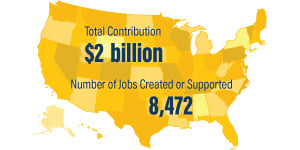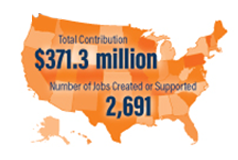NAFSA's latest analysis finds that international students studying at U.S. colleges and universities contributed $43.8 billion and supported 378,175 jobs to the U.S. economy during the 2023-2024 academic year.
NAFSA partners with JB International to conduct an annual state-by-state and congressional district analysis of the economic contributions of international students and their families to the U.S. economy.
The economic contributions of international students are in addition to the immeasurable academic and cultural value these students bring to our campuses and local communities.
International Students at U.S. Community Colleges
NAFSA's latest analysis finds that international students studying at U.S. community colleges contributed $2 billion and supported 8,472 jobs to the U.S. economy during the 2023-2024 academic year.
View state-by-state data in detail
Overall, international students studying at U.S. colleges and universities contribute $43.8 billion to the U.S. economy and support 378,175 jobs. NAFSA conducts an annual state-by-state and congressional district analysis of the economic contributions of international students and their families to the U.S. economy. The economic contributions of international students are in addition to the immeasurable academic and cultural value these students bring to our campuses and local communities.
International Students in U.S. College
and University English Language Programs
NAFSA's latest analysis finds that international students enrolled in English language programs at U.S. colleges and universities contributed $371.3 million and supported 2,691 jobs to the U.S. economy during the 2023-2024 academic year.
NAFSA Analysis: Methodology
Analysis produced for NAFSA by JB International.
International student enrollment data is provided by the Open Doors report published by the Institute of International Education in partnership with the Bureau of Educational and Cultural Affairs, U.S. Department of State.
Tuition and living expense data, which is used to calculate the total amount of economic benefit, comes from the U.S. Department of Education's National Center of Educational Statistics Integrated Postsecondary Education Data System (IPEDS).
Data sets used to calculate the number of jobs created or supported comes from the U.S. Department of Commerce, specifically International Trade Administration and Bureau of Economic Analysis.
For a detailed discussion, see "The Economic Benefits of International Student Enrollment to the U.S. Economy."



